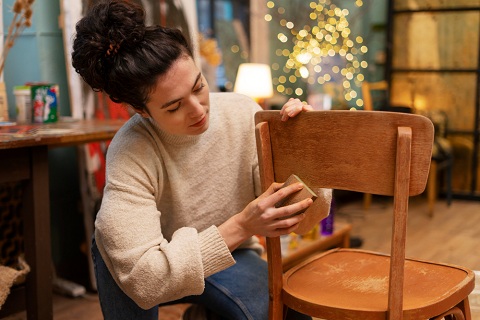In the realm of home decor, transforming old furniture is akin to uncovering hidden treasures. This practice not only breathes new life into otherwise discarded pieces but also enhances the aesthetic and monetary value of your home. Herein, we explore the art and science of furniture repair and restoration, revealing how it can significantly contribute to the charm and worth of your living space.
Understanding the Value of Old Furniture
Old furniture, often overlooked, holds significant potential. These pieces are typically crafted with superior materials and intricate craftsmanship, aspects rarely found in modern, mass-produced furniture. By repairing and restoring these items, you can harness their inherent quality and uniqueness, thereby enhancing your home’s decor.
Historical and Sentimental Worth
Antique furniture often carries a rich history. Each piece has its own story, making it a conversation starter and a cherished heirloom. Additionally, the sentimental value attached to family-owned furniture can make restoration a worthwhile endeavor, preserving memories while adding a touch of nostalgia to your decor.
Economic Benefits
Restoring old furniture can be more cost-effective than purchasing new high-quality pieces. Moreover, well-restored furniture can appreciate in value over time, especially if it is an antique. This makes furniture restoration not just an aesthetic decision but a savvy financial investment as well.
The Process of Furniture Restoration
Assessment and Planning
The first step in any restoration project is a thorough assessment of the furniture piece. Examine its current condition, identify damages, and determine what needs to be done. This phase often involves researching the piece’s history and original construction methods, which is crucial for a successful restoration.
Cleaning and Stripping
Cleaning is a vital part of the restoration process. Dirt, grime, and old finishes need to be removed to reveal the wood’s true condition. Depending on the furniture, this might involve gentle washing with soap and water, or more intensive methods such as using solvents or paint strippers.
Repairing Structural Damage
Structural repairs are essential to ensure the piece is functional and safe. This could involve regluing joints, replacing broken parts, or reinforcing weak areas. Skilled craftsmanship is required here to maintain the piece’s integrity and authenticity.
Surface Restoration
Surface restoration includes sanding, staining, and finishing. Sanding smooths out imperfections, while staining restores the wood’s natural color and highlights its grain. Applying a finish not only protects the wood but also enhances its appearance, giving it a fresh, polished look.
Reupholstering
For upholstered furniture, reupholstering is a key aspect of restoration. This process involves replacing old fabric and padding, which can dramatically change the look and comfort of the piece. Choosing high-quality, period-appropriate fabrics ensures the piece remains true to its original style while adding modern comfort.
Adding Value to Your Home Decor
Enhancing Aesthetic Appeal
Restored furniture adds a unique character to your home. Each piece, with its distinctive history and craftsmanship, serves as a focal point in any room. The blend of old and new elements creates a timeless appeal that can elevate your decor from ordinary to extraordinary.
Customization and Personalization
Restoring furniture allows for customization. You can choose finishes, fabrics, and colors that complement your home’s decor, ensuring each piece fits perfectly within your design scheme. This level of personalization makes your home truly one-of-a-kind.
Sustainability and Eco-Friendliness
In today’s environmentally conscious world, restoring old furniture is a sustainable choice. It reduces the need for new resources and minimizes waste, contributing to a greener planet. This eco-friendly approach not only enhances your decor but also aligns with modern values of sustainability.
Creating a Narrative
Every restored piece of furniture adds a story to your home. Whether it’s a family heirloom or a flea market find, these items carry a narrative that enriches your living space. This storytelling aspect adds depth and personality to your decor, making it more engaging and meaningful.
Practical Tips for Successful Furniture Restoration
Start Small
If you’re new to furniture restoration, start with smaller, less complex pieces. This allows you to build your skills and confidence before tackling more intricate projects.
Invest in Quality Tools
Having the right tools is crucial for successful restoration. Invest in high-quality tools such as sanders, clamps, and woodworking tools. These will make the process easier and ensure better results.
Learn and Experiment
Take the time to learn about different restoration techniques. There are numerous resources available, from books and online tutorials to workshops and courses. Don’t be afraid to experiment and develop your own methods.
Be Patient
Restoration is a meticulous process that requires patience. Rushing through it can lead to mistakes and subpar results. Take your time to ensure each step is done properly, resulting in a beautifully restored piece.
Seek Professional Help When Needed
Some restoration projects may require professional expertise, especially those involving antique or highly valuable pieces. Don’t hesitate to seek help from a professional restorer to ensure your piece is handled with the utmost care.
Conclusion
Repairing old furniture is more than just a cost-effective way to furnish your home; it’s an opportunity to create a unique, personalized living space rich in history and character. By breathing new life into old pieces, you not only enhance your home’s decor but also contribute to a more sustainable and meaningful way of living.





Find Us on Socials